You might meet one day one of the three street Nero that George Brown made in the late fifties although these are extremely rare. Here is the story of one them, usually nicknamed the “French Nero” because owned by the Frenchman Marc Bellon. Marc was the owner of a Rapide that had a serious propensity to wobble at high speed. Thus, when one of these road rodeos ended in a crash, fortunately minor for him and the bike, Marc decided to pay a visit to George Brown, convinced that the Nero architecture will sort out his bike issues.
Marc likes to tell that Georges said he was completely crazy and also perhaps because he turned up with his Rapide at Brown’s shop, George accepted to build a Nero replica for him. About a year later, the bike was ready, and as you could expect, the result was close to Brown’s racer. The all-front end had been replaced with an AJS 7R telescopic fork and conical brake, both wheels being wired with 19in aluminum rims. On the back end, a tubular sub-frame supporting the Velocette-based swinging arm, and Woodhead Munroe shocks were replacing the Vincent RFM (1), while the UFM (2) was preserved in the operation. In this configuration, the bike was significantly lighter than a stock Rapide (3). Two more Nero Replicas were subsequently built on this model by George Brown: one for a Scottish physician and the other one for a merchant of Eastbourne, all 3 bikes having a stock engine. Although, demand was coming steadily, George never had the time to accept new orders, maybe because he was already moving into his new project: designing and building Super Nero.
Back in France, Marc covered 10,000 miles before he was called on duty in the Algerian events (4). His friend, Marc Souvrain, was entrusted to take care of it, but when Marc came back, he found his bike in a non-running poor state of repair in which it remained for about 20 years. From the mid-80s, started a long process of restoration, long because Mark also wanted to improve the functionalities and the look of his bike: his vision was a combination of unpainted surfaces made of polished aluminum and chrome-plated parts.
The engine was sent to Herve Mocard, who rebuilt it completely with Mahle pistons, MkII cams, Alton generator and ported heads to fit the 30 mm concentric carburetors. The main structural modification was the replacement of the Vincent UFM by a custom-made backbone consisting of a large diameter tube to which a solid billet steering head is bolted. Eventually, Francois Grosset had the mission to put all these parts together and not only make the bike functional, but also meet Marc’s objectives in terms of finishing and details. On that perspective, particularly mention goes to: the “Nero style” aluminum tank, the horse-shoe aluminum oil tank fitting the rear frame properly (5), and various interesting parts made of aluminum such this rear chain case or headlamp and footrest brackets. Completing the picture were a lightweight Yamaha clutch, a Grosset electric start, a Feridax seat and a 5” shadow clock along with a Smith rev counter were adapted to the bike by Francois.
The restoration process completed in 1998, more than 35 years after Marc found his bike broken in crates. Was he satisfied with the result? You bet he was! This French Nero is indeed incredible in quality of the execution and is also extremely well balanced in its proportions. The bike is even lighter at 160 kg (353 lbs) and handles extremely well with its new UFM. Marc has enjoyed riding his Nero until 2009, date it was sold to a customer it in the UK.
Philippe Guyony © 2014

Picture © Marc Bellon

Picture © Marc Bellon
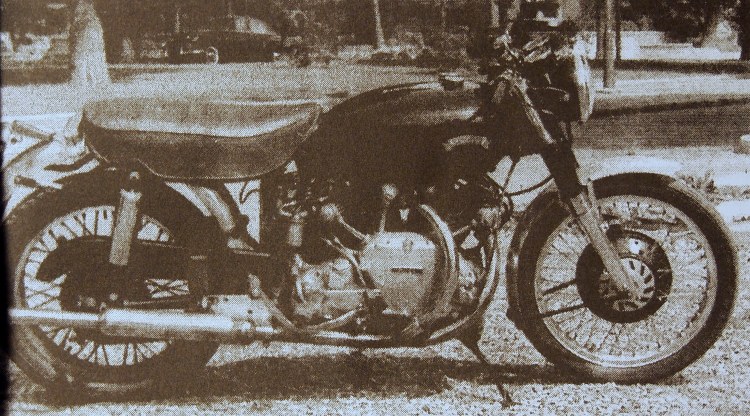

Picture © Michel Cottereau
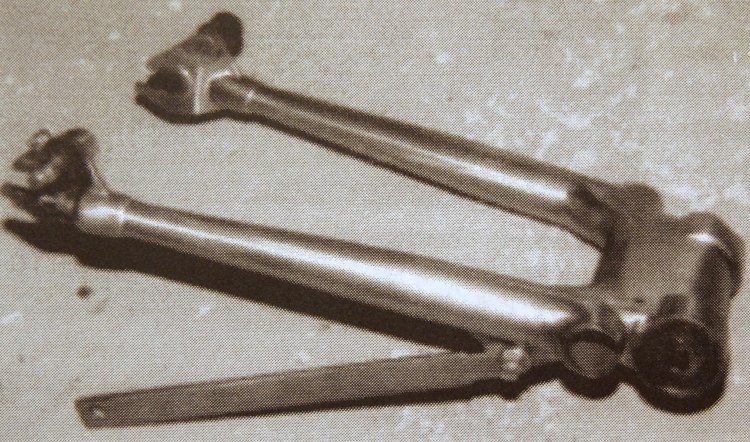
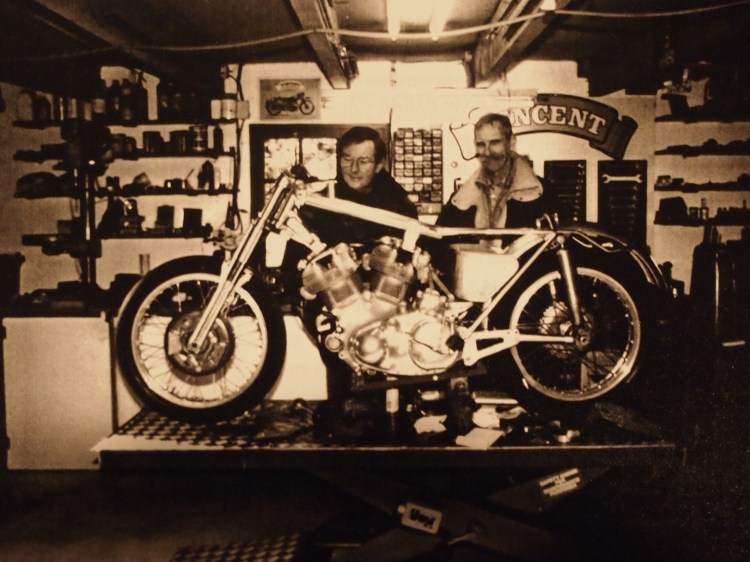
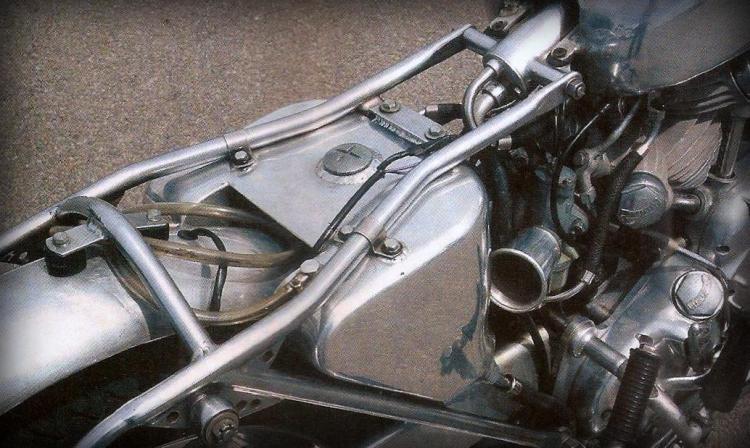
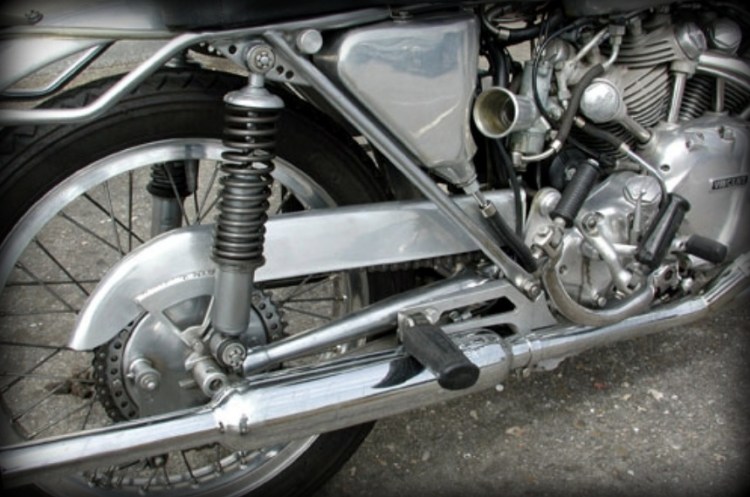
Picture © Michel Cottereau


A big thanks to the French section of the V.O.C. who helped me to assemble this documentation, particularly Serge Vollard (a.k.a Raspoutine), Jean Pirot, Francois Grosset and Dominique Malcor.
(1) The RFM is acronym for Rear Frame Member
(2) The UFM is acronym for Upper Frame Member, containing the engine oil
(3) Moto Revue #1496 tells about 50 kg (110 lbs), but this seems questionable
(4) These events lead to the independency of the Algeria, July 5, 1962.
(5) Originally Marc wanted to make the new UFM functional as the Vincent design. However down the road, he decided to add this Aluminum oil tank that fits perfectly the bike and thus converted the top tube as a drainable catch tank for the engine breather.
Sources: If you want more information about this bike you can try to find
– Classic Bike September 2002 (story Mike Duckworth)
– Classic Racer Winter 1990 (story Charlie Rous)
– Moto Revue #1496 06/19/1960 (story Marc Souvrain)
– Loup Garreau from VOC France #5 December 1998 (story Jean Pirot)
http://www.bikeexif.com/vincent-motorcycle-2
http://en.wikipedia.org/wiki/George_Brown_(motorcycle_racer)

Glenn Shriver asked me to try and replicate this, in stainless, for his Stainless framed Egli (Geratric Hooliganism).
I should have tried harder !
See page 49 of THE MOTOR CYCLE , 8 January 1959 , for photos and text.
THANK you SO much for this. I bought my Nero in 1971 in London when I was 21 ( we are the same age) with a Shadow engine in it. I was riding it yesterday and still brings intense joy. It handles so much better than a standard ( I have a Rapide). It is such a pleasure to see this motorcyle being recognise when all the pundits put it down because it is not a ‘real’ Shadow. Richard Faulkner. Perth Australia
Richard, can you contact me privately at 998lightning@gmail.com, Thanks, Philippe
I once owned a George Brown Special Vincent EJN188.It was built in 1959 standard Black Shadow engine&gearbox.I bought it in 1962,&sold it in1970.I now ride a Buell1125cr YJ59KWX.I wish i had kept the Vin,but we all make mistakes!Dave Watling ps,who owns the Vin now?
Fantastic, I will contact you privately on you email Address. Philippe
Hi Phillipe I am now the owner of EHN 188. since 1971. I live in perth Australia but am currently in India until next month Please feel free to contact me. Kind regards Richard
Dear Dave I know you! Your name is on my Vinnies log book. I bought her in 1971 and still ride her I Have 35 bikes but this one is a thing apart. Currently i am in up country India with intention of returning to Aus in June. I will contact you again subsrquently. Thank you so much for responding it is so excited to find out about her after all this time. Kind regards Richard P.s I still have the original number plate.
Hello Richard,im really pleased to hear from you.Im sure the#wasEJN188.I often think of her,&deeply regret selling her!Did you buy her from Ron Owen-Pullen?I bought her from him,&after about8years,sold her back to him,to buy a boat.I now ride a Buell1125cr.I envy you all your bikes,but i must say,im very fond of my Buell.I hope you continue to ride many happy miles on the Vin.Best regards,Dave Watling.
Gooday Dave. We have returned from India now and as indicated would like to follow up on the ejn 188 story. From the log book it is evident that Ronald Owen – Page bought the machine from the orginal purchaser but no date is present on the book. Your name appears as owner stamped 4.6.63 and then my name appears 9.8.71. Would I be correct in concluding that Ron was the individual that commissioned the George Brown Conversion rather than yourself and if so was there any paperwork that confirmed that Brown did the work himself? I also understand that 3 bikes were made to this order, one of which went tot Scotland and i wondered if anything was known about that one? If you are agreeable I would be happy to phone you at your convenience since I am sure there are things that get aired in a conversation which do not materialise in messages. Yours with kind regards . Richard
Hi Dave,
Sorry did you get the below message? If can help me please feel free to email me on faulk@iinet.net.au. Thank you.
Regards,
Richard